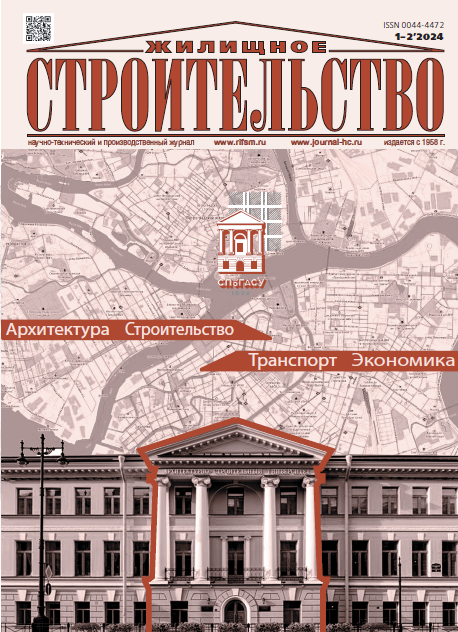Problems and Tasks of Building a Digital Information Model of Buildings for the Implementation of Housing Capital Repair Programs
- Авторлар: Popova O.N.1, Zaostrovskaya A.S.1, Yudina A.F.2
-
Мекемелер:
- Northern (Arctic) Federal University named after M.V. Lomonosov
- Saint-Petersburg Petersburg State University of Architecture and Civil Engineering
- Шығарылым: № 1-2 (2024)
- Беттер: 80-86
- Бөлім: Articles
- URL: https://innoscience.ru/0044-4472/article/view/635843
- DOI: https://doi.org/10.31659/0044-4472-2024-1-2-80-86
- ID: 635843
Дәйексөз келтіру
Аннотация
The purpose of the work is the development and use of digital information models (DIM) of apartment buildings (AB) of standard series of the Soviet period of construction at the stage of operation of the building. The stages and recommendations for the development of standard design DIM AB, requirements for the level of elaboration (detailing) of models are presented. The most common series of ABs in the central part of Arkhangelsk have been identified. With the help of Renga software, models have been developed for 4 standard series of AB. The level of elaboration is determined, on the one hand, by the possibility of using the model as an operational one without modification, on the other hand, by the possibility of refining it by increasing the level of detailing of the elements.
Толық мәтін
Авторлар туралы
O. Popova
Northern (Arctic) Federal University named after M.V. Lomonosov
Хат алмасуға жауапты Автор.
Email: oly-popova@yandex.ru
Candidate of Sciences (Engineering)
Ресей, 17, Severnaya Dvina Emb., Arkhangelsk, 163002A. Zaostrovskaya
Northern (Arctic) Federal University named after M.V. Lomonosov
Email: zaostrovskaya.a@gmail.com
Engineer
Ресей, 17, Severnaya Dvina Emb., Arkhangelsk, 163002A. Yudina
Saint-Petersburg Petersburg State University of Architecture and Civil Engineering
Email: yudinaantonina2017@mail.ru
Doctor of Sciences (Engineering)
Ресей, 4, 2nd Krasnoarmeyskaya Street, Saint Petersburg, 190005Әдебиет тізімі
- Ovsyannikova T.Y., Patsukov A.A. Information modeling technologies: strategic tasks and realities of digital transformation in construction. Nedvizhimost, economika, upravlenie. 2022. No. 1, pp. 13–18. (In Russian). DOI: https://doi.org/10.22337/2073-8412-2022-1-13-18
- Pertseva A.E., Volkova A.A., Khizhnyak N.S., Astafie- va N.S. Features of BIM-technology implementation in domestic organizations. Naukovedenie. 2017. Vol. 9. Nо. 6, pp. 1–8. (In Russian).
- Losev K.Yu., Losev Yu.G. To the methodology of automation of the life cycle of buildings and structures. Vestnik Eurasiiskoy nauki. 2022. Vol. 14. No. 1, pp. 1–13. (In Russian).
- Grakhov V.L., Kislyakova Y.G., Mokhnachev S.A., Simakov N.K. Economic aspects of implementing a digital twin of the building at the operation stage. Vestnik of the Institute of World Civilizations. 2021. Vol. 12. No. 4, pp. 39–45. (In Russian).
- Andreani Marta et al. 7d BIM for sustainability assessment in design processes: a case study of design of alternatives in severe climate and heavy use conditions. Architecture and Engineering. 2019. Vol. 4. No. 2, pp. 3–12. DOI: https://doi.org/10.23968/2500-0055-2019-4-2-3-12
- Bai, Qinghan et al. Application of BIM in the creation of prefabricated structures local parameterized component database. Architecture and Engineering. 2019. Vol. 4. No. 2, pp. 13–21. DOI: https://doi.org/10.23968/2500-0055-2019-4-2-13-21
- Bakhareva Olga; Kordonchik David. Investments in preservation and development of regional cultural heritage: a library of BIM elements representing national architectural and urban-planning landmarks. Architecture and Engineering. 2019. Vol. 4. No. 3, pp. 39–48. DOI: https://doi.org/10.23968/2500-0055-2019-4-3-39-48
- Shekhar Darshini; GODIHAL Jagdish. Evaluation of energy-cost-efficient design alternatives for residential buildings in karnataka’s tropical wet and dry climatic zones. Architecture and Engineering. 2023. Vol. 8. No. 3, pp. 23–31. doi: 10.23968/2500-0055-2023-8-3-23-31
- Gulik V.Yu. Prospects of BIM-technologies imple- mentation. Architectura, stroitelstvo, transport. 2021. No. 2, pp. 58–63. (In Russian).
- Beisembaeva S.A., Kalmagambetova A.Sh., Turaly- kova B.S. Applications of BIM-technologies at the stage of operation in buildings. Epocha nauki. 2021. No. 25, pp. 52–55. (In Russian).
- Shutova M.N., Plakhutina А.A., Kuzheleva V.A. Application of BIM-technologies in the development of architectural, structural and organizational-technological solutions of an industrial building. Stroitelstvo i architectura. 2021. No. 4, pp. 71–75. (In Russian).
- Rashev V.S., Astafieva N.S., Rogozhkin L.S., Grigoriev V.Y. Analysis of the implementation of information modeling technology in Russian construction companies for the design and construction of engineering systems. Vestnik Evraziyskoy nauki. 2020. No. 3, pp. 1–15. (In Russian).
- Telichenko V.I., Lapidus A.A., Morozenko A.A. Informatsionnoe modelirovanie tekhnologii i biznes-protsessov v stroitel’stve [Information modeling of technologies and business processes in construction]. Moscow: ASV. 2008. 144 p.
- Sheina S.G., Shuikov S.L. Normative regulation and experience of BIM implementation at different stages of life cycle in Russia. Modern trends in construction, urban planning and land use planning. 2023. Vol. 2. No. 1, pp. 4–11. (In Russian).
- Kuznetsov S.V., Knyazeva N.V. Application of information modeling for solving problems of maintenance and repair of buildings and structures. Vestnik of Belgorod State Technological University named after V.G. Shukhov. 2023. No. 3, pp. 34–45. (In Russian).
- Burchik V.V., Kuzmich N.P. Organization of the survey of buildings and structures for their further use. Vestnik grazhdanskih engenerov. 2023. No. 3 (98), pp. 54–60. (In Russian). doi: 10.23968/1999-5571-2022-19-3-171-177
Қосымша файлдар
















